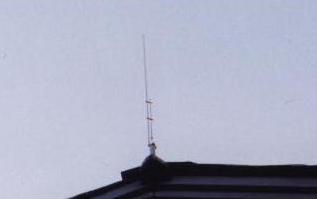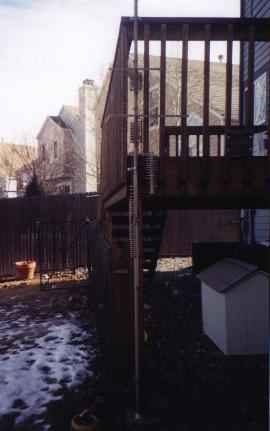 |
 |
 |
 |
 |
 |
 |
 |
 |
 |
 |
 |
 |
 |
 |
 |
 |
 |
 |
 |
 |
 |
 |
 |
 |
 |
 |
 |
 |
 |
 |
 |
 |
 |
 |
 |
 |
 |
 |
 |
 |
 |
 |
 |
 |
 |
 |
 |
 |
 |
 |
 |
 |
 |
 |
 |
 |
|
|
 |
|
|
|
 |
|
|
 |
|
|
|
|
|
|
|
|
Low Profile J Pole
|
|
|
17m Yagi, HF9V, G5RV
|
|
|
|
|
Low Profile Amateur Radio |
|
|
|
 |
|
|
|
|
Low profile operating OUTSIDE ANTENNAS |
|
|
|
|
|
|
Near Invisible G5RV Feed |
|
|
|
Antennas outside ? Not here ! Well you might be surprised. There are many methods to get your antennas out in the free air. The key here is do the very best you can to blend in or conceal your installation. Do your best not to attract attention. Install your antenna at night if possible, another way is to mix it in with some other project like painting, repairs or hanging christmas lights. |
|
|
|
PAINT A little paint does very little to your RF efficiency but goes a long way to disguise your antennas. Since my house is in the clear with few trees I use a blue-gray color that blends into the sky and in my case my house. Use a flat color if possible. Also there is a line of camouflage paints that are made for cars that are great around foliage, fences or decks. Experiment by painting boards ect. to see what will work best for you. |
|
|
|
VERTICALS Radials: On HF the length of the radials on the ground is is not a critical because the earth detunes them. Run as many as you can as close as you can to the 1/4 wave length for your lowest frequency. I would suggest that you bury them down about 1 inch. Radiator(s): On VHF & UHF full size and radiators are usually fairly easy to hide. For example use 3/16 rod instead of 1/2" tubing for your J-pole and paint to match, or hide it in a fake roof vent. Several amateurs have built 1/4 and even 5/8 wave antennas into a working windvane. On HF verticals can be built into "birdhouses" on a pole, these can be full sized on 10 meters or so and loaded or capacitance hats in the "house" itself for other bands. A popular theme is the flagpole antenna. One design for a multi band version is in the ARRL antenna book, it consists of a pole made of PVC with home made traps inside. Another good way is to feed a ground isolated 26 foot pole against a radial system with a concealed remote turner at its base. Also a wire radial can be run up a wood flag pole. Coax: Use a good quality coax cable to reduce RF & interaction problems. |
|
|
DIPOLES Dipoles can be very effective and also being balanced usually are some of the cleanest in terms of TVI and RFI. The eves of your house is a good spot to hide a dipole, just staple it up there and paint to match. Also a dipole laid flat on your roof can have good results. Inverted Vee configurations tend to work best to stateside contacts while flat tops high in the air work best for DX. A surprisingly good choice is the "invisible wire", small gauge wire as small as 30 gauge can be used if suspended properly, I suggest 26 gauge magnet wire. These small wire sizes will create some loss but not too much until you get to the low bands and even there will work ok. Also 18 gauge or so wire can be used and allowed to oxidize to have no reflection of sunlight. Caution with colors is necessary to prevent birds from running into your wire. I found light green is invisible to our feathered friends but they avoid dark green. These antennas can be supported by trees, fences ect. Fishing line is very useful for tying to structures and pulleys with small springs or weights can be used to let the dipole move in the wind without stretching. Feed line: A little care is needed here, be careful of running parallel to electrical lines or ductwork if using balanced lines. Use the best coax or twin lead you can but if you can use 300 ohm TV lead with some loss for easy routing. |
|
|
|
BEAMS This is a bit tougher, VHF & UHF beams can be hidden from view behind a chimneys or trees. HF beams even on 10m are big and hard to camouflage but a clever ham could possibly shorten one to look like a TV antenna. I expect to see more antennas like the new Hy-Gain 2/6 meter beam that looks a lot like a TV yagi and lets you take advantage of the Communication act of 1996. This FCC ruling states that if you own your property you can have a outdoor TV antenna despite local covenants ect. |
|
|
|
 |
|
|
MENU: |
|
|
|
|
|
MAIN |
|
|
|
|
|
 |
|
|
|
|
|
BACK |
|
|
|
|
|
|
|
WINDSURFING |
|
|
|
|
|
|
|
MX PICTURES |
|
|
|
|
|
|
|
RC GLIDERS |
|
|
|
|
|
|
|
MARTIAL ARTS |
|
|
|
|
|
|
|
|
|
 |
|
|
|
|
Links to other sites on the Web |
|
|
|
|
|
Can you see the antennas? All are up except the beam. |
|
|
|
|
|
|
|
|
|
|
 |
|
Train Racing! |
|
|
|
|
|
|
|
|
|
|
 |
|
|
|
|
|
|
 |
|
Out of This World Radi |
|
|
|
|
|
|
|
 |
|
NEW! AMATEUR RADIO LINKS |
|
|
|
|
|
|
|
|
|
|
HF9V bottom - painted - hard to see |
|
|
|
|
|
Disclaimer: All information & comments on these pages are my own and do not neccessarly reflect the opinions of Geocities and or my employer or its employees. |
|
|
|
© 2002 cholloway14@attbi.co |
|
|
|
|
|
|
|
This page hosted by |
|
 |
|
Get your own Free Home Page |
|
|
|













